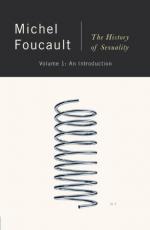
|
| Name: _________________________ | Period: ___________________ |
This test consists of 15 multiple choice questions and 5 short answer questions.
Multiple Choice Questions
1. What does Foucault mean when he refers to "power?"
(a) A general system of domination exerted by one group over another.
(b) A group of institutions and mechanisms to ensure the subservience of citizens of a given state.
(c) A multiplicity of force relations immanent in the sphere in which they operate.
(d) A mode of subjugation which has the form of rule.
2. Where did the most rigorous techniques of sexual restraint first occur?
(a) In the middle class.
(b) In the medical society.
(c) In the economically priviledged and politically dominant classes.
(d) In the uneducated working class.
3. Where would techniques of repression of sexuality first appear?
(a) In the educated middle class.
(b) In the religious of the upper class.
(c) Uniformally across society.
(d) In the labor class.
4. According to Foucault, the role of the family unit is NOT:
(a) To anchor sexuality and give it support.
(b) Allow alliance and sexuality to effect each other.
(c) All of the above.
(d) To be a social structure that restrains sexuality.
5. What are the "reasons for being" of the deployment of alliance compared to the deployment of sexuality?
(a) Making marital bonds paramount vs liberating sexuality.
(b) Control of the population vs expansion of perversions.
(c) Social law vs biological impulses that end in reproduction.
(d) Maintaining social law vs proliferating itself and controlling populations.
6. According to Foucault, which of the following is NOT one of the ways we view sex?
(a) As having been repressed for centuries.
(b) As something not to be taken into account.
(c) As something with influence over every aspect of our lives.
(d) As something obscure that needs to be investigated and understood.
7. Which of the rules regarding power and resistance is represented by the following example? In the nineteenth century the sex of a child was discussed between parents and educators or doctors. However, through modifications and shifts now the sexuality of a child is discussed between the child and a doctor with the sexuality of the parents called into question.
(a) Rule of the tactical polyvalence of discourses.
(b) Rule of immanence.
(c) Rules of continual variations.
(d) Rule of double conditioning.
8. What does Foucault say the universal taboo of incest has caused to happen?
(a) It has unified social strategies into the family unit.
(b) It has created multiple perversions.
(c) Secure sexuality under law and give alliance control over sexuality.
(d) It has brought sexual discourse into the home.
9. What is the feature of juridico-discursive power that Foucault labels as the uniformity of the apparatus?
(a) Figures of authority regarding sexuality present a uniform practice.
(b) Power over sex is exercised in the same way at all levels.
(c) The form of power mechanisms over sexuality is the same format of power found throughout society.
(d) Power over sex dictates a uniformity of sexuality.
10. What is the psychiatrization of perverse pleasure?
(a) The identification of the need of mental help to those of uncommon sexuality.
(b) The realization of pleasure in psychiatric discourse.
(c) The study of sex as a biological and psychical condition with pathologies that could be normalized.
(d) The labeling as the perverse as the essence of a person.
11. What does the hysterization of women's bodies refer to?
(a) The notion that women's bodies are hightly sexual and was predisposed to medical pathology.
(b) The identification of the female body as being at the root of female mental instability.
(c) The discovery that women's bodies created more emotional reaction than male bodies.
(d) The notion that the women's bodies are extreme manifestations of male counterparts.
12. What does Foucault say we can see the materialization of the rationality of power?
(a) Those who make pivotal economic decisions.
(b) At the restricted level where their tactics are inscribed.
(c) The caste which governs.
(d) The groups which control state apparatus.
13. What does the rule of the tactical polyvalence of discourses state?
(a) Discourse joins power and knowledge together, and its tactics are variable and changing.
(b) Every power manifests itself as new discourse.
(c) Discourse is multifaceted form of power.
(d) Knowledge generates discourse, which manifests power.
14. Which of the following definitions of sexuality would Foucault likely endorse?
(a) An element of power capable of serving as a tool for the most varied strategies.
(b) A transfer point for relations of power between people.
(c) All of the above.
(d) An element of power relations endowed with the greatest instrumentality.
15. What is the theory of "degenerescence?"
(a) The belief propogated that without medical help, sexual maladies will worsen until they consume the subject.
(b) Without control of social institutions the population will slowly rid itself of sexual rules.
(c) A heredity with maladies ended by producing a sexual pervert.
(d) Repression of sexuality degenerates with each generation.
Short Answer Questions
1. Which statement would Foucault agree with?
2. What can we expect discourses on sex to tell us?
3. What does Foucault say was an issue in the four strategies of power in regards to sexuality?
4. What does the rule of immanence state?
5. What does the rule of double conditioning state?
|
This section contains 959 words (approx. 4 pages at 300 words per page) |

|




